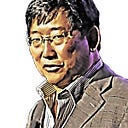More Kids in More Places
“I wish I was 25 again and starting over so that I could spend the rest of my life working with these new tools and technologies” Dr. Marc Lalande
This Pediatric Moonshot podcast episode features Dr. Marc Lalande, Vice President of Research at Shriners Hospital. In this 20 minute conversation we focus on his journey , his leadership role at Shriners and set the stage for discussions on the organization’s history, mission evolution, and the future of pediatric orthopedic care.
Marc’s career began at Boston Children’s Hospital during the early days of the Human Genome Project. Despite lacking formal genetics training, his involvement in separating chromosomes using a flow cytometry-based cell sort machine ignited his career in genetics. He worked extensively on rare pediatric disorders such as Prader-Willi Syndrome and Angelman Syndrome.
Transitioning to the University of Connecticut School of Medicine, Dr. Lalande continued his genetics research while embracing administrative responsibilities as the senior associate dean for research. In 2018, he seized the opportunity to become the Vice President of Research at Shriners Hospitals for Children, embarking on a mission to integrate the diverse clinical sites within the Shriners system.
Shriners Hospitals for Children, a philanthropic organization supported by temples across the United States, has a storied history dating back to 1922. Dr. Lalande details its mission evolution from initially focusing on polio to becoming a specialist in orthopedics. The organization’s unique focus areas include scoliosis, neuromuscular disorders, cleft lip and palate, and burns. Shriners Hospitals have treated close to 1.5 million children since their inception, making a substantial impact on the healthcare landscape. Today there are 20 different hospitals in North America and outreach clinics in Micronesia, Central America and Cyprus.
One of Marc’s roles is to paint a picture for the future of Shriners Hospitals. He imagines a future where we’ll have much more information on kids and their condition so we’ll be able to diagnose a child without them having to travel 400 or 4000 miles to a Shirners hospital. In the future he sees only a handful of brick and mortar Shriners hospitals. All the other ones are either surgery centers or combined surgery centers and clinics. While X-ray machines are the backbone of their current infrastructure in the future they will have the technology to look at kids movement remotely and diagnose in real time.
Shriners in the future will have developed AI orthopedic applications, which can be deployed globally, outside of the Shriners hospital network. As an example consider a hip dysplasia AI application which would be trained on Xray data from all 500 children’s hospitals, and deployed to every point of care Xray machine in the world. Such an application would reduce healthcare inequity, lower costs and improving patient outcomes, impacting many more kids in more places. Or from the Shriners website:
“Our ultimate goal internationally is to become the globally recognized resource for pediatric specialty care, training and research aimed at maximizing every child’s potential. We will accomplish this by treating more kids in more places — closer to their homes — building international capacity, leveraging our brand, expertise, membership and mission, and optimizing the use of our resources”
Please listen to the 20 minute podcast and subscribe to the podcast on Spotify or Apple, there are many more exciting guests to come.
